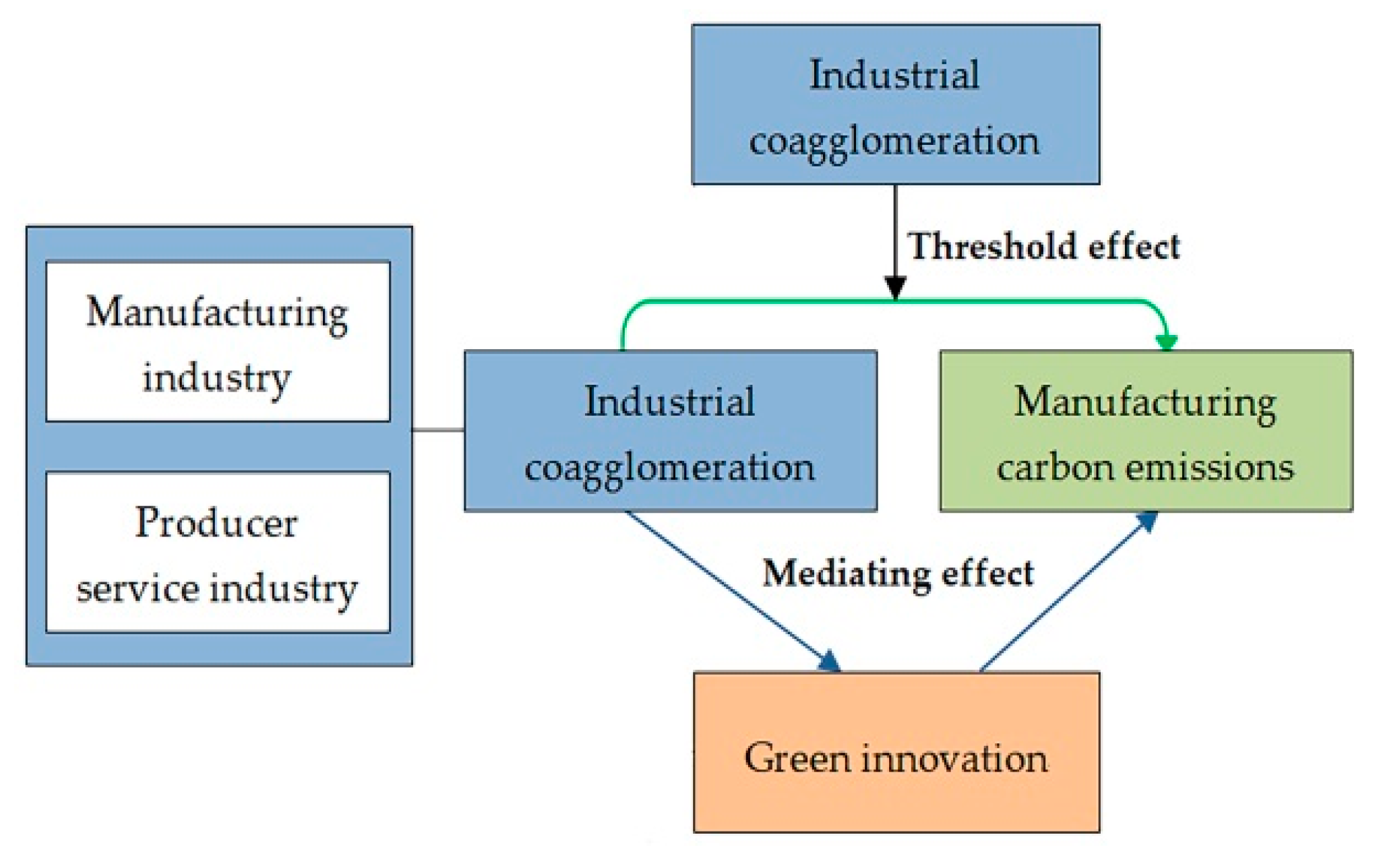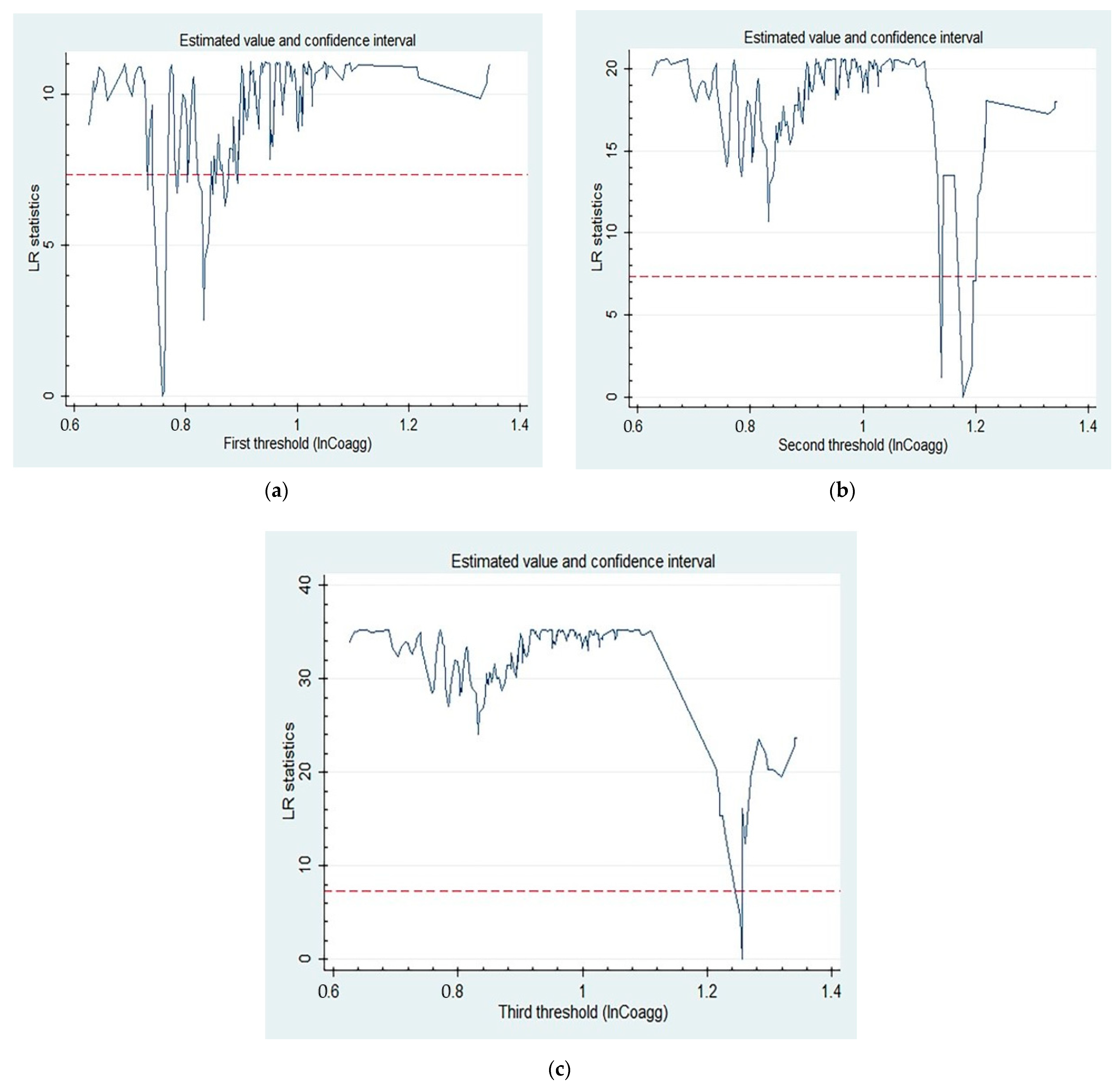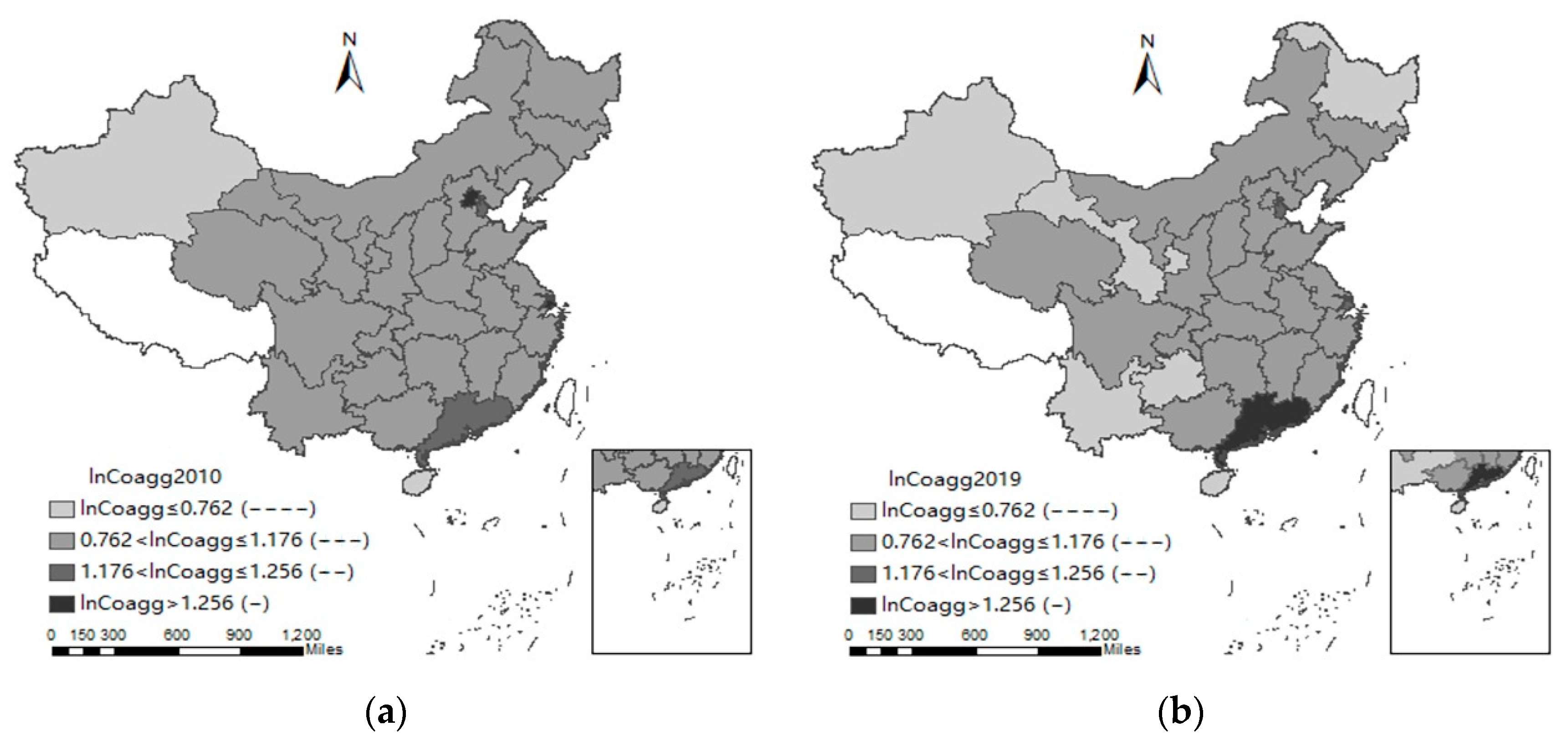Industrial Coagglomeration, Green Innovation, and Manufacturing Carbon Emissions: Coagglomeration’s Dynamic Evolution Perspective
Abstract
1. Introduction
2. Methods and Data
2.1. Extended STIRPAT Model
2.2. Panel-Threshold-STIRPAT Model
2.3. Mediation-STIRPAT Models
2.4. Variables and Data
2.4.1. Dependent Variable
2.4.2. Explanatory Variables
2.4.3. Intermediary Variable
2.4.4. Control Variables
3. Results
3.1. Unit Root Test and Multicollinearity Check
3.2. Industrial Coagglomeration’s Threshold Effect Regarding Its Impact on Manufacturing Carbon Emissions
3.2.1. Threshold Effect Tests
3.2.2. Results of Panel Threshold Regression
3.2.3. The Regional Distribution of the Industrial Coagglomeration Level
3.3. Green Innovation’s Mediating Effect between Industrial Coagglomeration and Manufacturing Carbon Emissions
3.4. Robustness Tests
4. Discussion
4.1. The Causes of Industrial Coagglomeration’s Threshold Effect
4.2. The Causes of Green Innovation’s Mediating Effect
4.3. Limitations and Future Research
5. Conclusions and Policy Implications
5.1. Conclusions
5.2. Policy Implications
Author Contributions
Funding
Institutional Review Board Statement
Informed Consent Statement
Data Availability Statement
Conflicts of Interest
References
- Chen, P.; Gao, J.; Ji, Z.; Liang, H.; Peng, Y. Do Artificial Intelligence Applications Affect Carbon Emission Performance?—Evidence from Panel Data Analysis of Chinese Cities. Energies 2022, 15, 5730. [Google Scholar] [CrossRef]
- Cheng, S.; Fan, W.; Meng, F.; Chen, J.; Cai, B.; Liu, G.; Liang, S.; Song, M.; Zhou, Y.; Yang, Z. Toward Low-Carbon Development: Assessing Emissions-Reduction Pressure among Chinese Cities. J. Environ. Manag. 2020, 271, 111036. [Google Scholar] [CrossRef] [PubMed]
- Zeng, N.; Jiang, K.; Han, P.; Hausfather, Z.; Cao, J.; Kirk-Davidoff, D.; Ali, S.; Zhou, S. The Chinese Carbon-Neutral Goal: Challenges and Prospects. Adv. Atmos. Sci. 2022, 39, 1229–1238. [Google Scholar] [CrossRef] [PubMed]
- Liu, J.; Yang, Q.; Ou, S.; Liu, J. Factor Decomposition and the Decoupling Effect of Carbon Emissions in China’s Manufacturing High-Emission Subsectors. Energy 2022, 248, 123568. [Google Scholar] [CrossRef]
- An, Y.; Zhou, D.; Yu, J.; Shi, X.; Wang, Q. Carbon Emission Reduction Characteristics for China’s Manufacturing Firms: Implications for Formulating Carbon Policies. J. Environ. Manag. 2021, 284, 112055. [Google Scholar] [CrossRef]
- Hang, Y.; Wang, Q.; Zhou, D.; Zhang, L. Factors Influencing the Progress in Decoupling Economic Growth from Carbon Dioxide Emissions in China’s Manufacturing Industry. Resour. Conserv. Recycl. 2019, 146, 77–88. [Google Scholar] [CrossRef]
- Lyu, R.; Zhang, C.; Li, Z.; Li, Y. Manufacturers’ Integrated Strategies for Emission Reduction and Recycling: The Role of Government Regulations. Comput. Ind. Eng. 2022, 163, 107769. [Google Scholar] [CrossRef]
- Howard, E.; Newman, C.; Tarp, F. Measuring Industry Coagglomeration and Identifying the Driving Forces. J. Econ. Geogr. 2016, 16, 1055–1078. [Google Scholar] [CrossRef]
- Meng, X.-N.; Xu, S.-C. Can Industrial Collaborative Agglomeration Reduce Carbon Intensity? Empirical Evidence Based on Chinese Provincial Panel Data. Environ. Sci. Pollut. Res. 2022, 29, 61012–61026. [Google Scholar] [CrossRef]
- Ellison, G.; Glaeser, E.L. Geographic Concentration in U.S. Manufacturing Industries: A Dartboard Approach. J. Polit. Econ. 1997, 105, 889–927. [Google Scholar] [CrossRef]
- Ellison, G.; Glaeser, E.L.; Kerr, W.R. What Causes Industry Agglomeration? Evidence from Coagglomeration Patterns. Am. Econo. Rev. 2010, 100, 1195–1213. [Google Scholar] [CrossRef]
- Venables, A.J. Equilibrium Locations of Vertically Linked Industries. Int. Econ. Rev. 1996, 37, 341. [Google Scholar] [CrossRef]
- Ke, S.; He, M.; Yuan, C. Synergy and Co-Agglomeration of Producer Services and Manufacturing: A Panel Data Analysis of Chinese Cities. Reg. Stud. 2014, 48, 1829–1841. [Google Scholar] [CrossRef]
- Lanaspa, L.; Sanz-Gracia, F.; Vera-Cabello, M. The (Strong) Interdependence between Intermediate Producer Services’ Attributes and Manufacturing Location. Econ. Model. 2016, 57, 1–12. [Google Scholar] [CrossRef]
- Lu, N.; Feng, S.; Liu, Z.; Wang, W.; Lu, H.; Wang, M. The Determinants of Carbon Emissions in the Chinese Construction Industry: A Spatial Analysis. Sustainability 2020, 12, 1428. [Google Scholar] [CrossRef]
- Xu, W.; Yang, P.; Xiao, Y. Will the Special Economic Zone Contribute to Carbon Neutrality? Quasi-Natural Experimental Evidence from China. Appl. Econ. Lett. 2022, 1–13. [Google Scholar] [CrossRef]
- Huang, Q.; Hu, Y.; Luo, L. Spatial Analysis of Carbon Dioxide Emissions from Producer Services: An Empirical Analysis Based on Panel Data from China. Environ. Sci. Pollut. Res. 2022, 29, 53293–53305. [Google Scholar] [CrossRef]
- Chen, D.; Chen, S.; Jin, H. Industrial Agglomeration and CO2 Emissions: Evidence from 187 Chinese Prefecture-Level Cities over 2005–2013. J. Clean. Prod. 2018, 172, 993–1003. [Google Scholar] [CrossRef]
- Peng, H.; Wang, Y.; Hu, Y.; Shen, H. Agglomeration Production, Industry Association and Carbon Emission Performance: Based on Spatial Analysis. Sustainability 2020, 12, 7234. [Google Scholar] [CrossRef]
- Sun, Z.; Liu, Y. Does Industrial Agglomeration Promote Carbon Efficiency? A Spatial Econometric Analysis and Fractional-Order Grey Forecasting. J. Math. 2021, 2021, 5242414. [Google Scholar] [CrossRef]
- Li, T.; Han, D.; Feng, S.; Liang, L. Can Industrial Co-Agglomeration between Producer Services and Manufacturing Reduce Carbon Intensity in China? Sustainability 2019, 11, 4024. [Google Scholar] [CrossRef]
- Zhang, L.; Mu, R.; Hu, S.; Zhang, Q.; Wang, S. Impacts of Manufacturing Specialized and Diversified Agglomeration on the Eco-Innovation Efficiency—A Nonlinear Test from Dynamic Perspective. Sustainability 2021, 13, 3809. [Google Scholar] [CrossRef]
- Zhang, L.; Mu, R.; Hu, S.; Yu, J.; Zhang, J. Industrial Coagglomeration, Technological Innovation, and Environmental Pollution in China: Life-Cycle Perspective of Coagglomeration. J. Clean. Prod. 2022, 362, 132280. [Google Scholar] [CrossRef]
- Böhringer, C.; Rivers, N. The Energy Efficiency Rebound Effect in General Equilibrium. J. Environ. Manag. 2021, 109, 102508. [Google Scholar] [CrossRef]
- Yan, Y.; Li, J.; Xu, Y. Research on Industry Difference and Convergence of Green Innovation Efficiency of Manufacturing Industry in China Based on Super-SBM and Convergence Models. Math. Probl. Eng. 2021, 2021, 4013468. [Google Scholar] [CrossRef]
- Shi, R.; Cui, Y.; Zhao, M. Role of Low-Carbon Technology Innovation in Environmental Performance of Manufacturing: Evidence from OECD Countries. Environ. Sci. Pollut. Res. 2021, 28, 68572–68584. [Google Scholar] [CrossRef]
- Lin, S.; Chen, Z.; He, Z. Intra-City Industrial Collaborative Agglomeration, Inter-City Network Connectivity and Green Technology Innovation. Sustainability 2021, 13, 8835. [Google Scholar] [CrossRef]
- Wu, H. Threshold Effect of Collaborative Agglomeration of Internet and High-Tech Industry on Green Innovation. In Forthcoming Networks and Sustainability in the IoT Era; Al-Turjman, F., Rasheed, J., Eds.; Lecture Notes on Data Engineering and Communications Technologies; Springer International Publishing: Cham, Switzerland, 2022; Volume 129, pp. 249–256. ISBN 978-3-030-99615-4. [Google Scholar]
- Yang, H.; Xu, X.; Zhang, F. Industrial Co-Agglomeration, Green Technological Innovation, and Total Factor Energy Efficiency. Environ. Sci. Pollut. Res. 2022, 29, 62475–62494. [Google Scholar] [CrossRef]
- Zeng, W.; Li, L.; Huang, Y. Industrial Collaborative Agglomeration, Marketization, and Green Innovation: Evidence from China’s Provincial Panel Data. J. Clean. Prod. 2021, 279, 123598. [Google Scholar] [CrossRef]
- Yang, N.; Yuan, X.; Qin, F.; Qian, F. Coagglomeration of Manufacturing and Producer Services: How Does It Affect Regional Innovation in China? Appl. Spatial Anal. 2022. [Google Scholar] [CrossRef]
- Lee, K.-H.; Min, B. Green R&D for Eco-Innovation and Its Impact on Carbon Emissions and Firm Performance. J. Clean. Prod. 2015, 108, 534–542. [Google Scholar] [CrossRef]
- Mandal, A.; Pal, B. Effects of Green Innovation and Advertisement in an Imperfect Production-based Competitive Supply Chain under Two-tier Credit Facility. Math. Method Appl. Sci. 2021, 44, 13227–13251. [Google Scholar] [CrossRef]
- Zhu, J.; Dou, Z.; Yan, X.; Yu, L.; Lu, Y. Exploring the Influencing Factors of Carbon Neutralization in Chinese Manufacturing Enterprises. Environ. Sci. Pollut. Res. 2022. [Google Scholar] [CrossRef]
- Danish; Ulucak, R. Renewable Energy, Technological Innovation and the Environment: A Novel Dynamic Auto-Regressive Distributive Lag Simulation. Renew. Sust. Energ. Rev. 2021, 150, 111433. [Google Scholar] [CrossRef]
- Vélez-Henao, J.-A.; Font Vivanco, D.; Hernández-Riveros, J.-A. Technological Change and the Rebound Effect in the STIRPAT Model: A Critical View. Energy Policy 2019, 129, 1372–1381. [Google Scholar] [CrossRef]
- Ehrlich, P.R.; Holdren, J.P. Impact of Population Growth: Complacency Concerning This Component of Man’s Predicament Is Unjustified and Counterproductive. Science 1971, 171, 1212–1217. [Google Scholar] [CrossRef] [PubMed]
- Waggoner, P.E.; Ausubel, J.H. A framework for sustainability science: A renovated IPAT identity. Proc. Natl. Acad. Sci. USA 2002, 99, 7860–7865. [Google Scholar] [CrossRef]
- Li, Z.; Li, Y.B.; Shao, S.S. Analysis of Influencing Factors and Trend Forecast of Carbon Emission from Energy Consumption in China Based on Expanded STIRPAT Model. Energies 2019, 12, 3054. [Google Scholar] [CrossRef]
- Dietz, T.; Rosa, E.A. Effects of Population and Affluence on CO 2 Emissions. Proc. Natl. Acad. Sci. USA 1997, 94, 175–179. [Google Scholar] [CrossRef]
- Huo, T.; Cao, R.; Du, H.; Zhang, J.; Cai, W.; Liu, B. Nonlinear Influence of Urbanization on China’s Urban Residential Building Carbon Emissions: New Evidence from Panel Threshold Model. Sci. Total Environ. 2021, 772, 145058. [Google Scholar] [CrossRef]
- Chang, K.L.; Du, Z.F.; Chen, G.J.; Zhang, Y.X.; Sui, L.L. Panel estimation for the impact factors on carbon dioxide emissions: A new regional classification perspective in China. J. Clean. Prod. 2021, 279, 123637. [Google Scholar] [CrossRef]
- Li, W.; Wang, W.; Wang, Y.; Qin, Y. Industrial Structure, Technological Progress and CO2 Emissions in China: Analysis Based on the STIRPAT Framework. Nat. Hazards 2017, 88, 1545–1564. [Google Scholar] [CrossRef]
- Wang, Z.; Zhu, Y. Do Energy Technology Innovations Contribute to CO2 Emissions Abatement? A Spatial Perspective. Sci. Total Environ. 2020, 726, 138574. [Google Scholar] [CrossRef] [PubMed]
- Hansen, B.E. Threshold Effects in Non-Dynamic Panels: Estimation, Testing, and Inference. J. Econom. 1999, 93, 345–368. [Google Scholar] [CrossRef]
- Wang, W.; Li, Y.; Lu, N.; Wang, D.; Jiang, H.; Zhang, C. Does Increasing Carbon Emissions Lead to Accelerated Eco-Innovation? Empirical Evidence from China. J. Clean. Prod. 2020, 251, 119690. [Google Scholar] [CrossRef]
- MacKinnon, D.P.; Lockwood, C.M.; Hoffman, J.M.; West, S.G.; Sheets, V. A Comparison of Methods to Test Mediation and Other Intervening Variable Effects. Psychol. Methods 2002, 7, 83–104. [Google Scholar] [CrossRef]
- Xie, R.; Yao, S.; Han, F.; Fang, J. Land Finance, Producer Services Agglomeration, and Green Total Factor Productivity. Int. Reg. Sci. Rev. 2019, 42, 550–579. [Google Scholar] [CrossRef]
- Waiengnier, M.; Van Hamme, G.; Hendrikse, R.; Bassens, D. Metropolitan Geographies of Advanced Producer Services: Centrality and Concentration in Brussels. Tijds. Econ. Soc. Geog. 2020, 111, 585–600. [Google Scholar] [CrossRef]
- Levin, A.; Lin, C.-F.; Chu, C.-S.J. Unit Root Tests in Panel Data: Asymptotic and Finite Sample Properties. J. Econ. 2002, 108, 1–24. [Google Scholar] [CrossRef]
- Wang, X.; Luo, Y. Has Technological Innovation Capability Addressed Environmental Pollution from the Dual Perspective of FDI Quantity and Quality? Evidence from China. J. Clean. Prod. 2020, 258, 120941. [Google Scholar] [CrossRef]
- Li, K.; Fang, L.; He, L. How Urbanization Affects China’s Energy Efficiency: A Spatial Econometric Analysis. J. Clean. Prod. 2018, 200, 1130–1141. [Google Scholar] [CrossRef]
- Zhang, T.; Su, P.; Deng, H. Does the Agglomeration of Producer Services and the Market Entry of Enterprises Promote Carbon Reduction? An Empirical Analysis of the Yangtze River Economic Belt. Sustainability 2021, 13, 13821. [Google Scholar] [CrossRef]
- Shearmur, R.; Doloreux, D. Innovation and Knowledge-Intensive Business Service: The Contribution of Knowledge-Intensive Business Service to Innovation in Manufacturing Establishments. Econ. Innov. New Technol. 2013, 22, 751–774. [Google Scholar] [CrossRef]



| Variables | Observations | Mean | Maximum | Minimum | Standard Deviation |
|---|---|---|---|---|---|
| lnMce | 300 | 4.324 | 6.171 | 1.126 | 0.909 |
| lnCoagg | 300 | 0.952 | 1.387 | 0.584 | 0.167 |
| lnGi | 300 | 7.417 | 10.364 | 3.044 | 1.382 |
| lnPs | 300 | 8.201 | 9.352 | 6.333 | 0.736 |
| lnEl | 300 | 0.525 | 2.433 | −0.352 | 0.354 |
| lnOd | 300 | −2.901 | −0.965 | −5.467 | 0.987 |
| lnEcsci | 300 | −0.586 | −0.012 | −1.286 | 0.268 |
| lnEi | 300 | −3.145 | −1.135 | −5.538 | 0.873 |
| Variables | LLC Test (Trend) | VIF |
|---|---|---|
| lnMce | −9.0286 *** | - |
| lnCoagg | −5.1665 *** | 2.49 |
| lnGi | −6.7596 *** | 4.40 |
| lnPs | −4.9522 *** | 3.20 |
| lnEl | −6.2835 *** | 1.78 |
| lnOd | −10.8109 *** | 2.46 |
| lnEcsci | −8.8136 *** | 2.01 |
| lnEi | −5.6441 *** | 3.58 |
| Mean VIF | - | 2.85 |
| Models | Threshold Estimates | F-Value | p-Value | 1% | 5% | 10% | 95% Confidence Interval |
|---|---|---|---|---|---|---|---|
| Single-threshold | 1.256 | 35.286 *** | 0.000 | 21.064 | 9.322 | 5.596 | [1.139, 1.256] |
| Double-threshold | 1.176 1.256 | 18.066 ** | 0.030 | 24.306 | 14.080 | 7.092 | [1.139, 1.201] [1.245, 1.256] |
| Triple-threshold | 0.762 | 10.844 ** | 0.040 | 19.276 | 10.271 | 6.376 | [0.732, 0.893] |
| Variable | Model (1) | Variable | Model (1) |
|---|---|---|---|
| lnCoagg ≤ 0.762 | −0.980 *** (−2.71) | lnOd | −0.003 (−0.09) |
| 0.762 < lnCoagg ≤ 1.176 | −0.728 ** (−2.23) | lnEcsci | −0.480 *** (−4.37) |
| 1.176 < lnCoagg ≤ 1.256 | −0.362 (−1.14) | lnEi | 0.012 (0.32) |
| lnCoagg > 1.256 | −0.094 (−0.31) | Constant | 12.592 ** (2.55) |
| lnGi | 0.141 *** (4.66) | Obs | 300 |
| lnPs | −1.083 * (−1.73) | R-sq | 0.5457 |
| lnEl | −0.087 ** (−2.11) | F statistics | 11.54 *** |
| Variable | Total Effect (DEPVAR = lnMce) Model (2) | Variable | Direct Effect (DEPVAR = lnMce) Model (1) | Variable | Indirect Effect (DEPVAR = lnGi) Model (3) |
|---|---|---|---|---|---|
| lnCoagg ≤ 1.139 | −0.814 *** (−2.62) | lnCoagg ≤ 0.762 | −0.980 *** (−2.71) | lnCoagg | −3.055 *** (−5.45) |
| 1.139 < lnCoagg ≤ 1.256 | −0.542 * (−1.77) | 0.762 < lnCoagg ≤ 1.176 | −0.728 ** (−2.23) | - | - |
| lnCoagg > 1.256 | −0.226 (−0.77) | 1.176 < lnCoagg ≤ 1.256 | −0.362 (−1.14) | - | - |
| - | - | lnCoagg > 1.256 | −0.094 (−0.31) | - | - |
| lnGi | - | lnGi | 0.141 *** (4.66) | - | - |
| Constant | −6.905 * (−1.78) | Constant | 12.592 ** (2.55) | Constant | −105.509 *** (14.12) |
| Control variables | Yes | Control variables | Yes | Control variables | Yes |
| Obs | 300 | Obs | 300 | Obs | 300 |
| R-sq | 0.6171 | R-sq | 0.5457 | R-sq | 0.8025 |
| F statistics | 8.36 *** | F statistics | 11.54 *** | F statistics | 178.81 *** |
| Variable | Total Effect (DEPVAR = lnMce) Model (4) | Variable | Direct Effect (DEPVAR = lnMce) Model (5) | Variable | Indirect Effect (DEPVAR = lnGi) Model (6) |
|---|---|---|---|---|---|
| lnCoagg ≤ 1.139 | −0.814 *** (−2.62) | lnCoagg ≤ 0.762 | −1.085 *** (−3.02) | lnCoagg | −2.945 *** (−4.67) |
| 1.139 < lnCoagg ≤ 1.256 | −0.542 * (−1.77) | 0.762 < lnCoagg ≤ 1.176 | −0.829 ** (−2.57) | - | - |
| lnCoagg > 1.256 | −0.226 (−0.77) | 1.176 < lnCoagg ≤ 1.256 | −0.446 (−1.42) | - | - |
| - | - | lnCoagg > 1.256 | −0.178 (−0.59) | - | - |
| lnGi | - | lnGi | 0.120 *** (4.44) | ||
| Constant | −6.905 * (−1.78) | Constant | 10.834 ** (2.26) | Constant | −107.878 *** (−12.83) |
| Control variables | Yes | Control variables | Yes | Control variables | Yes |
| Obs | 300 | Obs | 300 | Obs | 300 |
| R-sq | 0.6171 | R-sq | 0.5133 | R-sq | 0.7940 |
| F statistics | 8.36 *** | F statistics | 11.28 *** | F statistics | 169.54 *** |
| Variable | Total Effect (DEPVAR = lnMce) Model (7) | Variable | Direct Effect (DEPVAR = lnMce) Model (8) | Variable | Indirect Effect (DEPVAR = lnGi) Model (9) |
|---|---|---|---|---|---|
| lnCoaggt−1 ≤ 0.762 | −1.253 *** (−3.42) | lnCoaggt−1 ≤ 0.762 | −0.816 ** (−2.18) | lnCoaggt−1 | −7.825 *** (−7.48) |
| 0.762 < lnCoaggt−1 ≤ 1.237 | −0.996 *** (−3.15) | 0.762 < lnCoagg t−1 ≤ 1.237 | −0.541 (−1.64) | - | - |
| lnCoaggt−1 > 1.237 | −0.654 ** (−2.13) | lnCoaggt−1 > 1.237 | −0.206 (−0.64) | - | - |
| lnGi | - | lnGi | 0.061 *** (3.84) | - | - |
| Constant | 5.267 *** (17.29) | Constant | 4.383 *** (11.66) | Constant | 14.905 *** (14.89) |
| Control variables | No | Control variables | No | Control variables | No |
| Obs | 300 | Obs | 300 | Obs | 300 |
| R-sq | 0.0592 | R-sq | 0.0168 | R-sq | 0.1724 |
| F statistics | 13.10 *** | F statistics | 14.01 *** | F statistics | 56.02 *** |
Publisher’s Note: MDPI stays neutral with regard to jurisdictional claims in published maps and institutional affiliations. |
© 2022 by the authors. Licensee MDPI, Basel, Switzerland. This article is an open access article distributed under the terms and conditions of the Creative Commons Attribution (CC BY) license (https://creativecommons.org/licenses/by/4.0/).
Share and Cite
Zhang, L.; Mu, R.; Fentaw, N.M.; Zhan, Y.; Zhang, F.; Zhang, J. Industrial Coagglomeration, Green Innovation, and Manufacturing Carbon Emissions: Coagglomeration’s Dynamic Evolution Perspective. Int. J. Environ. Res. Public Health 2022, 19, 13989. https://doi.org/10.3390/ijerph192113989
Zhang L, Mu R, Fentaw NM, Zhan Y, Zhang F, Zhang J. Industrial Coagglomeration, Green Innovation, and Manufacturing Carbon Emissions: Coagglomeration’s Dynamic Evolution Perspective. International Journal of Environmental Research and Public Health. 2022; 19(21):13989. https://doi.org/10.3390/ijerph192113989
Chicago/Turabian StyleZhang, Lu, Renyan Mu, Nigatu Mengesha Fentaw, Yuanfang Zhan, Feng Zhang, and Jixin Zhang. 2022. "Industrial Coagglomeration, Green Innovation, and Manufacturing Carbon Emissions: Coagglomeration’s Dynamic Evolution Perspective" International Journal of Environmental Research and Public Health 19, no. 21: 13989. https://doi.org/10.3390/ijerph192113989
APA StyleZhang, L., Mu, R., Fentaw, N. M., Zhan, Y., Zhang, F., & Zhang, J. (2022). Industrial Coagglomeration, Green Innovation, and Manufacturing Carbon Emissions: Coagglomeration’s Dynamic Evolution Perspective. International Journal of Environmental Research and Public Health, 19(21), 13989. https://doi.org/10.3390/ijerph192113989










